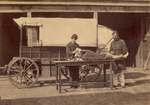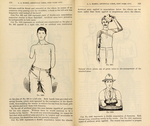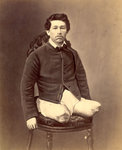Introduction
Advances in military technology during the American Civil War, especially the invention of the rifled musket (which allowed for more accurate firing) and the Minié ball (a bullet with a cylindrical body and pointed convex nose that penetrated more deeply and could shatter bone), led to devastating wounds which often required amputation of a limb. Around 60,000 amputations were performed during the four years of the Civil War, amounting to three-quarters of all the surgical operations done during the war (Figg 1993).
The objects and books used in this display highlight the tools and techniques used for those amputations. As a companion to the traveling exhibit Life and Limb: The Toll of the American Civil War from the National Library of Medicine, it demonstrates the grisly realities of the thousands of amputations that were done, on and off the battlefield, during the Civil War.
Credits
Curated and designed by Ramune Kubilius, MALS, AHIP, Collection Development/Special Projects Librarian; Corinne Miller, MLIS, Clinical Informationist; and Q. Eileen Wafford, MSt, MLIS, AHIP, Research Librarian
Civil War-era surgical kit from Galter Special Collections.
Lower leg splint from Galter Special Collections.
Demonstration of the use of anesthesia in amputations. Via National Museum of Health and Medicine.
Grace, W. The Army Surgeon’s Manual; For the Use of Medical Officers, Cadets, Chaplains, and Hospital Stewards.... 2nd ed. New York: Baillière Brothers; 1865.
The most frequently amputated appendages during the American Civil War were fingers and toes. The Union, alone, reported an estimated minimum of 9421 hand, finger, foot, and toe amputations during the course of the war (Figg 1993).
Shown here are illustrations of various finger amputation techniques, such as the removal of the second metacarpal by the oval method (see Figure 25, plate 4).
Chisolm, Julian John. A Manual of Military Surgery : Prepared for the Use of the Confederate States Army. Richmond, Va: Ayres & Wade, Illustrated News Steam Presses, 1863.
Marks, G.E. A treatise on artificial limbs with rubber hands and feet. New York: A.A. Marks; 1902. 530 p.
The American medical times being a weekly series of the New York journal of medicine. New York: Baillière Brothers. Vol. 1 (July 7, 1860)-v. 9, no. 10 (Sept. 3, 1864).
Private Columbus Rush, Company C, 21st Georgia, age 22, was wounded during the assault on Fort Stedman, Virginia, on March 25, 1865, by a shell fragment that fractured both the right leg below the knee and the left kneecap.
Both limbs were amputated above the knees on the same day. He recovered quickly and was discharged from Lincoln Hospital in Washington on Aug. 2, 1865. In 1866, while being treated at St. Luke’s Hospital in New York City, he was outfitted with artificial limbs.
- The American medical times being a weekly series of the New York journal of medicine. New York: Baillière Brothers 8, no. 5 (January 30, 1864).
- Chisolm, Julian John. A Manual of Military Surgery : Prepared for the Use of the Confederate States Army. Richmond, Va: Ayres & Wade, Illustrated News Steam Presses, 1863.
- Figg, Laurann, and Jane Farrell-Beck. "Amputation in the Civil War: Physical and Social Dimensions." Journal of the history of medicine and allied sciences 48, no. 4 (1993): 454-75. https://doi.org/10.1093/jhmas/48.4.454
- Grace, William. The Army Surgeon's Manual; for the Use of Medical Officers, Cadets, Chaplains, and Hospital Stewards Containing the Regulations of the Medical Department, All General Orders from the War Department, and Circulars from the Surgeon-General's Office from January 1st, 1861, to April 1st, 1865. 2d ed. New York: Baillière, 1865.
- Marks, George E. A Treatise on Artificial Limbs with Rubber Hands and Feet. New York: A.A. Marks, 1902
Exhibit Details
Using objects and books from the library’s collection, this display illustrates the grisly realities of amputation as the major medical procedure of the American Civil War.
-
- Location
- Library Atrium
- Date
- Apr 27, 2017 - Oct 16, 2017
- Contact
- ghsl-specialcollections@northwestern.edu
- Links
- View the NLM digital exhibit
- Subjects
- surgery
- military medicine
- american history
- american civil war







